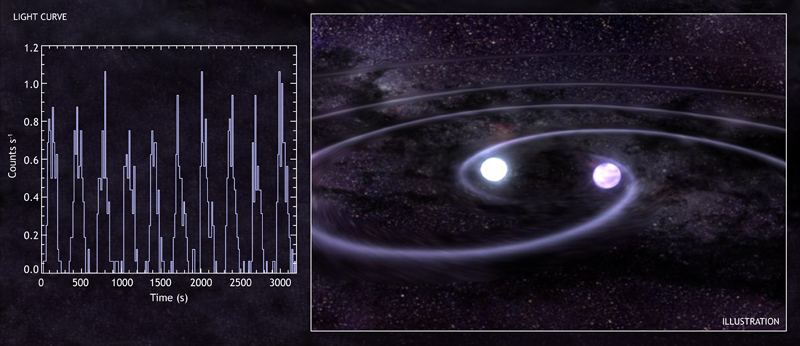NASA Sees Orbiting Stars Flooding Space With Gravitational Waves
Message boards :
SETI@home Science :
NASA Sees Orbiting Stars Flooding Space With Gravitational Waves
Message board moderation
| Author | Message |
|---|---|
 Byron Leigh Hatch @ team Carl Sagan Byron Leigh Hatch @ team Carl Sagan Send message Joined: 5 Jul 99 Posts: 4548 Credit: 35,667,570 RAC: 4 
|
PRESS RELEASE Date Released: Monday, May 30, 2005 Source Marshall Space Flight Center NASA Sees Orbiting Stars Flooding Space With Gravitational Waves A scientist using NASA's Chandra X-ray Observatory has found evidence that two white dwarf stars are orbiting each other in a death grip, destined to merge. The data indicate gravitational waves are carrying energy away from the star system at a prodigious rate, making it a prime candidate for future missions designed to directly detect these ripples in space-time. Einstein's General Theory of Relativity predicted a binary star system should emit gravitational waves that rush away at the speed of light and cause the stars to move closer together. As the stars move closer together, the orbital period decreases, and it can be measured by Chandra. The orbital period of this system is decreasing by 1.2 milliseconds every year. This is a rate consistent with the theory that predicted loss of energy due to gravitational waves. _____________________________ <A><B>please click the Graphic for more information</B>[/url] _____________________________  ______________________________ A scientist using NASA's Chandra X-ray Observatory has found evidence that two white dwarf stars are orbiting each other in a death grip, destined to merge. The data indicate gravitational waves are carrying energy away from the star system at a prodigious rate, making it a prime candidate for future missions designed to directly detect these ripples in space-time. Einstein's General Theory of Relativity predicted a binary star system should emit gravitational waves that rush away at the speed of light and cause the stars to move closer together. As the stars move closer together, the orbital period decreases, and it can be measured by Chandra. The orbital period of this system is decreasing by 1.2 milliseconds every year. This is a rate consistent with the theory that predicted loss of energy due to gravitational waves. The system is known as RX J0806.3+1527 or J0806. The white dwarf pair in J0806 might have the smallest orbit of any known binary system. The stars are only about 50,000 miles apart, a fifth of the distance from the Earth to the moon. As the stars swirl closer together, traveling in excess of one million mph, the production of gravitational waves increases. "If confirmed, J0806 could be one of the brightest sources of gravitational waves in our galaxy," said Tod Strohmayer of NASA's Goddard Space Flight Center, Greenbelt, Md. He presented data today at the American Astronomical Society meeting in Minneapolis. "It could be among the first to be directly detected with an upcoming space mission called LISA, the Laser Interferometer Space Antenna," he added. White dwarfs are remnants of stars that have used up all their fuel. Along with neutron stars and black holes, white dwarfs are called compact objects, because they pack a lot of mass into a small volume. The white dwarfs in the J0806 system each have an estimated mass of one-half the sun, yet are only about the size of Earth. Optical and X-ray observations of J0806 showed periodic variations of 321.5 seconds, barely more than five minutes. The observation in J0806 is most likely the orbital period of the white dwarf system. However the possibility that it represents the spin of one of its white dwarfs cannot be completely ruled out. "It's either the most compact binary known or one of the most unusual systems we've ever seen. Either way it's got a great story to tell," Strohmayer said. Strohmayer's Chandra X-ray observations tighten orbital decay estimates made through optical independent observations by other research teams. Strohmayer's data will be published in an upcoming issue of The Astrophysical Journal. NASA's Marshall Space Flight Center, Huntsville, Ala., manages the Chandra program for NASA's Science Mission Directorate. The Smithsonian Astrophysical Observatory controls science and flight operations from the Chandra X-ray Center in Cambridge, Mass. For additional Chandra information and images on the Internet, visit: http://chandra.harvard.edu/ http://chandra.nasa.gov/ http://www.spaceref.com/news/viewpr.html?pid=16974 |
 Sir Ulli Sir Ulli Send message Joined: 21 Oct 99 Posts: 2246 Credit: 6,136,250 RAC: 0 
|
Thanks for this Science Report Byron :) Greetings from Germany NRW Ulli  S@h Berkeley's Staff Friends Club m7 © S@h Berkeley's Staff Friends Club m7 © |

©2024 University of California
SETI@home and Astropulse are funded by grants from the National Science Foundation, NASA, and donations from SETI@home volunteers. AstroPulse is funded in part by the NSF through grant AST-0307956.